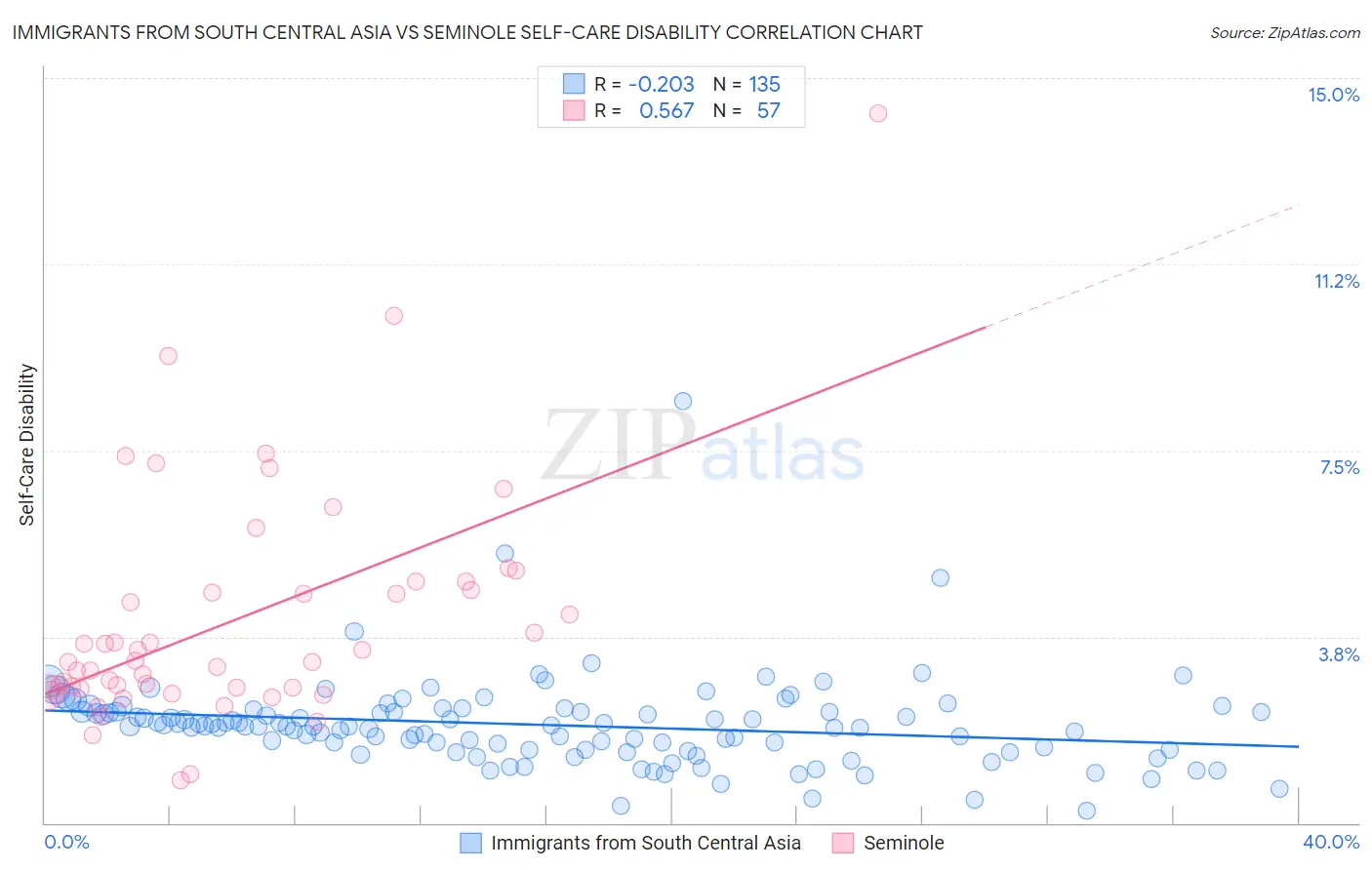Immigrants from South Central Asia vs Seminole Self-Care Disability
COMPARE
Immigrants from South Central Asia
Seminole
Self-Care Disability
Self-Care Disability Comparison
Immigrants from South Central Asia
Seminole
2.2%
SELF-CARE DISABILITY
100.0/ 100
METRIC RATING
11th/ 347
METRIC RANK
2.9%
SELF-CARE DISABILITY
0.0/ 100
METRIC RATING
323rd/ 347
METRIC RANK
Immigrants from South Central Asia vs Seminole Self-Care Disability Correlation Chart
The statistical analysis conducted on geographies consisting of 472,250,690 people shows a weak negative correlation between the proportion of Immigrants from South Central Asia and percentage of population with self-care disability in the United States with a correlation coefficient (R) of -0.203 and weighted average of 2.2%. Similarly, the statistical analysis conducted on geographies consisting of 118,265,141 people shows a substantial positive correlation between the proportion of Seminole and percentage of population with self-care disability in the United States with a correlation coefficient (R) of 0.567 and weighted average of 2.9%, a difference of 31.1%.

Self-Care Disability Correlation Summary
| Measurement | Immigrants from South Central Asia | Seminole |
| Minimum | 0.25% | 0.86% |
| Maximum | 8.5% | 14.3% |
| Range | 8.2% | 13.4% |
| Mean | 2.0% | 4.1% |
| Median | 1.9% | 3.2% |
| Interquartile 25% (IQ1) | 1.5% | 2.7% |
| Interquartile 75% (IQ3) | 2.2% | 4.8% |
| Interquartile Range (IQR) | 0.78% | 2.1% |
| Standard Deviation (Sample) | 0.92% | 2.4% |
| Standard Deviation (Population) | 0.92% | 2.3% |
Similar Demographics by Self-Care Disability
Demographics Similar to Immigrants from South Central Asia by Self-Care Disability
In terms of self-care disability, the demographic groups most similar to Immigrants from South Central Asia are Immigrants from Ethiopia (2.2%, a difference of 0.050%), Ethiopian (2.2%, a difference of 0.070%), Sudanese (2.2%, a difference of 0.10%), Luxembourger (2.2%, a difference of 0.23%), and Okinawan (2.2%, a difference of 0.23%).
| Demographics | Rating | Rank | Self-Care Disability |
| Immigrants | Singapore | 100.0 /100 | #4 | Exceptional 2.1% |
| Zimbabweans | 100.0 /100 | #5 | Exceptional 2.2% |
| Filipinos | 100.0 /100 | #6 | Exceptional 2.2% |
| Immigrants | Bolivia | 100.0 /100 | #7 | Exceptional 2.2% |
| Bolivians | 100.0 /100 | #8 | Exceptional 2.2% |
| Immigrants | Nepal | 100.0 /100 | #9 | Exceptional 2.2% |
| Sudanese | 100.0 /100 | #10 | Exceptional 2.2% |
| Immigrants | South Central Asia | 100.0 /100 | #11 | Exceptional 2.2% |
| Immigrants | Ethiopia | 100.0 /100 | #12 | Exceptional 2.2% |
| Ethiopians | 100.0 /100 | #13 | Exceptional 2.2% |
| Luxembourgers | 100.0 /100 | #14 | Exceptional 2.2% |
| Okinawans | 100.0 /100 | #15 | Exceptional 2.2% |
| Immigrants | Kuwait | 100.0 /100 | #16 | Exceptional 2.2% |
| Immigrants | Saudi Arabia | 100.0 /100 | #17 | Exceptional 2.2% |
| Immigrants | Taiwan | 100.0 /100 | #18 | Exceptional 2.2% |
Demographics Similar to Seminole by Self-Care Disability
In terms of self-care disability, the demographic groups most similar to Seminole are Cherokee (2.9%, a difference of 0.10%), Comanche (2.9%, a difference of 0.12%), Navajo (2.9%, a difference of 0.45%), Chickasaw (2.9%, a difference of 0.60%), and Immigrants from Uzbekistan (2.9%, a difference of 0.63%).
| Demographics | Rating | Rank | Self-Care Disability |
| Menominee | 0.0 /100 | #316 | Tragic 2.8% |
| Immigrants | Dominica | 0.0 /100 | #317 | Tragic 2.8% |
| Assyrians/Chaldeans/Syriacs | 0.0 /100 | #318 | Tragic 2.8% |
| Spanish American Indians | 0.0 /100 | #319 | Tragic 2.9% |
| Chickasaw | 0.0 /100 | #320 | Tragic 2.9% |
| Navajo | 0.0 /100 | #321 | Tragic 2.9% |
| Comanche | 0.0 /100 | #322 | Tragic 2.9% |
| Seminole | 0.0 /100 | #323 | Tragic 2.9% |
| Cherokee | 0.0 /100 | #324 | Tragic 2.9% |
| Immigrants | Uzbekistan | 0.0 /100 | #325 | Tragic 2.9% |
| Paiute | 0.0 /100 | #326 | Tragic 2.9% |
| Blacks/African Americans | 0.0 /100 | #327 | Tragic 2.9% |
| Hopi | 0.0 /100 | #328 | Tragic 2.9% |
| Cajuns | 0.0 /100 | #329 | Tragic 2.9% |
| Nepalese | 0.0 /100 | #330 | Tragic 3.0% |